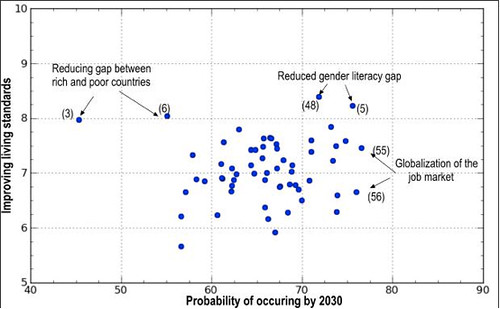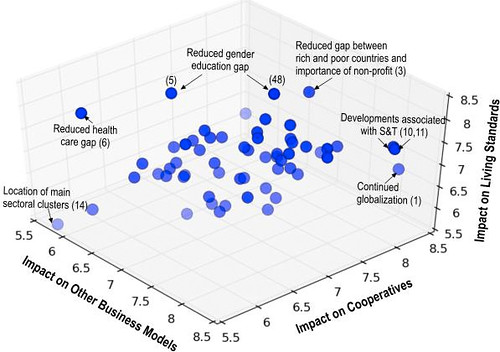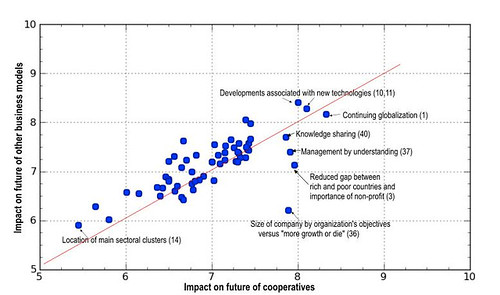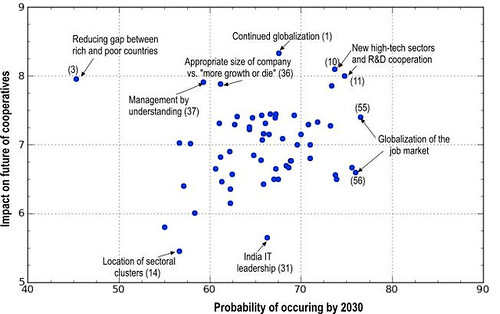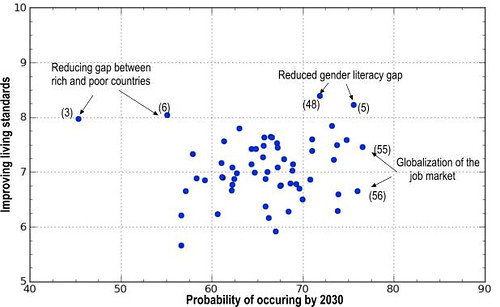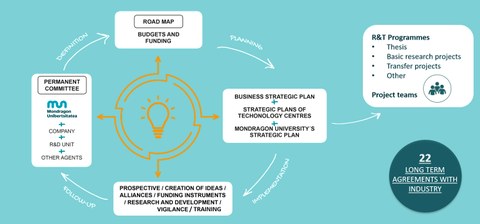

Cooperatives 2030: Some Factors Impacting the Future of Cooperatives and Business
The United Nations designated 2012 as the International Year of Cooperatives. The intent is to raise awareness about the contributions of cooperative enterprises to economic and social development and to achieving the Millennium Development Goals.
In response, Prospektiker in collaboration with LKS, Mondragon, and The Millennium Project conducted a Real-Time Delphi study to explore the future of cooperatives and other business approaches. It identified key factors affecting the future of cooperatives as well as the probable future developments for these factors. An international panel of over 100 experts from 38 countries provided inputs.
The initial questions and statements of the RTD were based on an extensive review of existing research, reliable data sources, and tested assumptions. The participants were invited to answer questions about 59 developments, 11 variables, and 2 that were open-ended.
The panel concluded that the development of cooperatives can be a major generator of employment and development. Cooperatives fared well compared with other business models for improving the standard of living. Thus the cooperatives movement should be considered as a significant option for developing economies to help reduce the rich-poor gap.
Future developments that were rated as having the highest impacts (8 and higher on a scale of 1 to 10) on the future of both cooperatives and other business organizations were globalization and future technological developments. For example:
-
Main future sectors will be in the high-tech area (from space to agri-food) and will include nanotechnology, micro and nano electronics, biotechnology, photonics, new materials, and advanced manufacturing technologies. (11)
-
In the case of technological development and investments in R&D, the establishment of partnerships and cooperation networks will increase. In addition to the financial advantages, synergies will be developed in various fields as a result of collaborative agreements between companies, universities, and research centers. (10)
-
Globalization will continue, with the growth of exports and foreign direct investment greater than that of GDP. (1)
The results show that the geographic location has the lowest impact on all aspects considered in the study.
Figures 1 and 2 show high-impact developments on both cooperatives and other corporate organizations, while showing some differences. For example, the impacts on living standards were rated higher from cooperatives than from other business organizations.
Figure 1. Impacts of Developments on the Future of Cooperatives, other Business Organizations, and Improving Living Standards
Figure 2. Impact of Developments on the Future of Cooperatives and Other Business Models
In particular, developments important to improving the standards of living—such as those related to partnerships, improved management, reduced rich-poor gap, and expansion of ethical markets—correlate better to the future of cooperatives than to that of other business organization models, as shown in Figure 3. For example, adjusting the size of the company to the organization’s objectives instead of seeking growth as an end in itself (36), and management by understanding versus by authority (37) were considered significant for cooperatives and for improving the standard of living, but with lower importance to the future of other business organizations.
Figure 3. Impact on the Future of Cooperatives and on Improving Living Standards
It is important to identify the correlation between the importance of developments to the future of cooperatives, or to improving the living standards, and their probability of occurring, so that developments that have an important positive impact can be encouraged, if possible. Similarly, increased importance should be given to the developments that were judged as having the highest potential for improving living standards but low probability of occurring by 2030. The graphs in Figure 4 and 5 show these correlations.
Figure 4. Probability of Occurring by 2030 and Potential Impact on the Future of Cooperatives
Figure 5. Impact on Improving Living Standards and Probability of Occurring by 2030











